Delayed Development of Resistance to QoI Fungicide in Venturia inaequalis in Israeli Apple Orchards and Improved Apple Scab Management Using Fungicide Mixtures
Abstract
1. Introduction
2. Materials and Methods
2.1. Fungicides
2.2. Field Trials
2.2.1. Experimental Design of Field Trials
2.2.2. Changes in the Efficacy of QoI Fungicides in the Control of Apple Scab
2.2.3. Relationship between Average Rainfall (mm) in Season, Number of QoI Sprays per Season and Years until Occurrence of Resistance to QoI
2.2.4. Field Trials to Examine the Efficacy of QoI Fungicides against Apple Scab
2.3. Activity of QoI Fungicides on Mycelial Growth of V. inaequalis In Vitro
2.3.1. Collection of Fungal Isolates
2.3.2. Inhibition of Mycelial Growth of V. inaequalis In Vitro
2.4. PCR-Based Detection of the G143A Mutation in V. inaequalis
2.5. Molecular Detection of the G143A CYTB Gene Mutation by Direct Sequencing
2.6. Use of Fungicidal Mixtures for Improving Efficacy against V. inaequalis
2.6.1. Use of Fungicidal Mixtures for Improving Efficacy In Vitro
2.6.2. Use of Fungicidal Mixtures for Improving Efficacy in Field Trials
2.7. Assessment of Fruits and Leaves Infected with Apple Scab
2.8. Data Analysis
3. Results
3.1. Changes in the Effciacy of QoI Fungicides in the Control of Apple Scab
3.2. Relationship between Average Rainfall (mm) in Season, Number of QoI Sprays per Season and Years until Occurrence of Resistance to QoI
3.3. Field Trials to Examine the Efficacy of QoI Fungicides against Apple Scab
3.4. In Vitro Inhibition of Mycelial Growth of V. inaequalis
3.5. PCR-Based Detection of the G143A Mutation in V. inaequalis
3.6. Molecular Detection of the G143A CYTB Gene Mutation by Direct Sequencing
3.7. Use of Fungicidal Mixtures for Improving Efficacy
4. Discussion
5. Conclusions
Supplementary Materials
Author Contributions
Funding
Data Availability Statement
Acknowledgments
Conflicts of Interest
References
- MacHardy, W.E. Apple Scab: Biology, Epidemiology, and Management; APS Press: St. Paul, MN, USA, 1996. [Google Scholar]
- Biggs, A.R.; Stensvand, A. Apple scab. In Compendium of Apple and Pear Diseases and Pests; Sutton, T.B., Aldwinckle, H.S., Agnello, A.M., Walgenbach, J.F., Eds.; APS: St. Paul, MN, USA, 2014. [Google Scholar]
- Alaniz, S.; Leoni, C.; Bentancur, O.; Mondino, P. Elimination of summer fungicide sprays for apple scab (Venturia inaequalis) management in Uruguay. Sci. Hort. 2014, 165, 331–335. [Google Scholar] [CrossRef]
- Reuveni, M.; Levy, K.; Gur, L.; Frenkel, O.; Burg, D.; Ovadia, S.; Farber, A.; Shahar, A. Occurrence of Venturia inaequalis resistance to QoI fungicides in Israel apple orchards. Phytoparasitica 2016, 44, 277. (In Abstract) [Google Scholar]
- Shabi, E.; Roberts, A.L.; Crute, I.R.; Boehm, E.W.A.; Oppenheim, D.; Elisha, S.; Katan, T. Variation in sensitivity of Venturia inaequalis to DMI and strobilurin fungicides. Phytoparasitica 1997, 25, 260–261. (In Abstract) [Google Scholar]
- Chatzidimopoulos, M.; Lioliopoulou, F.; Sotiropoulos, T.; Vellios, E. Efficient control of apple scab with targeted spray applications. Agronomy 2020, 10, 217. [Google Scholar] [CrossRef]
- Bartlett, D.W.; Clough, J.M.; Godwin, J.R.; Hall, A.A.; Hamer, M.; Parr-Dobrzanski, B. The strobilurin fungicides. Pest Manag. Sci. 2002, 58, 649–662. [Google Scholar] [CrossRef] [PubMed]
- Ishii, H.; Fraaije, B.A.; Sugiyama, T.; Noguchi, K.; Nishimura, K.; Takeda, T.; Amano, T.; Hollomon, D.W. Occurrence and molecular characterization of strobilurin resistance in cucumber powdery mildew and downy mildew. Phytopathology 2001, 91, 1166–1171. [Google Scholar] [CrossRef]
- Jiang, J.; Ding, L.; Michailides, T.J.; Li, H.; Ma, Z. Molecular characterization of field azoxystrobin-resistant isolates of Botrytis cinerea. Pestic Biochem. Physiol. 2009, 93, 72–76. [Google Scholar] [CrossRef]
- Sierotzki, H.; Wullschleger, J.; Gisi, U. Point mutation in cytochrome b gene conferring resistance to strobilurin fungicides in Erysiphe graminis f. sp. tritici field isolates. Pestic Biochem. Physiol. 2000, 68, 107–112. [Google Scholar] [CrossRef]
- Zheng, D.; Olaya, G.; Köller, W. Characterization of laboratory mutants of Venturia inaequalis resistant to the strobilurin-related fungicide kresoxim-methyl. Curr. Genet. 2000, 38, 148–155. [Google Scholar] [CrossRef]
- Olaya, G.; & Köller, W. Baseline sensitivities of Venturia inaequalis populations to the strobilurin fungicide kresoxim-methyl. Plant Dis. 1999, 83, 274–278. [Google Scholar] [CrossRef] [PubMed]
- Fontaine, S.; Remuson, F.; Fraissinet-Tachet, L.; Micoud, A.; Marmeisse, R.; Melayah, D. Monitoring of Venturia inaequalis harbouring the QoI resistance G143A mutation in French orchards as revealed by PCR assays. Pest Manag. Sci. 2009, 65, 74–81. [Google Scholar] [CrossRef]
- Küng Färber, R.B.; Chin, K.M.; Leadbitter, N. Sensitivity of Venturia inaequalis to trifloxystrobin. Pest Manag. Sci. 2002, 58, 261–267. [Google Scholar] [CrossRef] [PubMed]
- Köller, W.; Parker, D.M.; Turechek, W.W.; Avila-Adame, C.; Cronshaw, K. A two-phase resistance response of Venturia inaequalis populations to the QoI fungicides kresoxim-methyl and trifloxystrobin. Plant Dis. 2004, 88, 537–544. [Google Scholar] [CrossRef]
- Fiaccadori, R.; Cicognani, E.; Alberoni, G.; Collina, M.; Brunelli, A. Sensitivity to strobilurin fungicides of Italian Venturia inaequalis populations with different origin and scab control. Pest Manag. Sci. 2011, 67, 535–540. [Google Scholar] [CrossRef]
- Mondino, P.; Casanova, L.; Celio, A.; Bentancur, O.; Leoni, C.; Alaniz, S. Sensitivity of Venturia inaequalis to trifloxystrobin and difenoconazole in Uruguay. J. Phytopathol. 2015, 163, 1–10. [Google Scholar] [CrossRef]
- Stević, M.; Tamaš, N.; Miletić, N.; Vukša, P. Different toxicity of the strobilurin fungicides kresoxim-methyl and trifloxistrobin to Venturia inaequalis isolates from Serbia. J. Environ. Sci. Health B 2015, 50, 633–637. [Google Scholar] [PubMed]
- Turan, C. Study of Venturia Inaequalis Sensitivity to Fungicides through Molecular and Biological Methodologies. Ph.D. Thesis, University of Bologna, Bologna, Italy, 2013. [Google Scholar]
- Turan, C.; Nanni, I.M.; Tosun, N.; Collina, M. First report of QoI resistance in Venturia inaequalis causing apple scab in apple orchards in Turkey. Plant Dis. 2016, 100, 1016. [Google Scholar] [CrossRef]
- Boehm, E.W.A.; Freeman, S.; Shabi, E.; Michailides, T.J. Microsatellite primers indicate the presence of asexual populations of Venturia inaequalis in coastal Israeli apple orchards. Phytoparasitica 2003, 31, 236–251. [Google Scholar] [CrossRef]
- Gur, L.; Reuveni, M.; Cohen, Y. Occurrence and etiology of Alternaria leaf blotch and fruit spot of apple caused by Alternaria alternata f. sp. mali on cv. Pink Lady in Israel. Eur. J. Plant Pathol. 2017, 147, 695–708. [Google Scholar] [CrossRef]
- Villani, S.M.; Cox, K.D. Heteroplasmy of the cytochrome b gene in Venturia inaequalis and its involvement in quantitative and practical resistance to trifloxystrobin. Phytopathology 2014, 104, 945–953. [Google Scholar] [CrossRef] [PubMed]
- Sallato, B.V.; Latorre, B.A.; Aylwin, G. First report of practical resistance to QoI fungicides in Venturia inaequalis (apple scab) in Chile. Plant Dis. 2006, 90, 375. [Google Scholar] [CrossRef]
- Turechek, W.W.; Köller, W. Managing resistance of Venturia inaequalis to the strobilurin fungicides. Plant Health Prog. 2004, 5, 3. [Google Scholar] [CrossRef]
- Köller, W.; Wilcox, W.F.; Parker, D.M. Sensitivity of Venturia inaequalis populations to anilinopyrimidine fungicides and their contribution to scab management in New York. Plant Dis. 2005, 89, 357–365. [Google Scholar] [CrossRef]
- Fiaccadori, R.; Cicognani, E.; Abbatecola, A.; Collina, M.; Brunelli, A. Sensitivity of Venturia inaequalis to strobilurin fungicides in Italy. Commun. Agric. Appl. Biol. Sci. 2005, 70, 73. [Google Scholar]
- Zheng, D.; Köller, W. Characterization of the mitochondrial cytochrome b gene from Venturia inaequalis. Curr. Genet. 1997, 32, 361–366. [Google Scholar] [CrossRef]
- Ebrahimi, L.; Fotuhifar, K.B.; Nikkhah, M.J.; Naghavi, M.R.; Baisakh, N. Population genetic structure of apple scab (Venturia inaequalis (Cooke) G. Winter) in Iran. PLoS ONE 2016, 11, e0160737. [Google Scholar]
- Gladieux, P.; Zhang, X.G.; Afoufa-Bastien, D.; Sanhueza, R.M.V.; Sbaghi, M.; Le Cam, B. On the origin and spread of the scab disease of apple: Out of central Asia. PLoS ONE 2008, 3, e1455. [Google Scholar] [CrossRef] [PubMed]
- Chapman, K.S.; Sundin, G.W.; Beckerman, J.L. Identification of resistance to multiple fungicides in field populations of Venturia inaequalis. Plant Dis. 2011, 95, 921–926. [Google Scholar] [CrossRef]
- Fiaccadori, R. Researches on methodologies to verify reduced sensitivities of Venturia inaequalis in field to difenoconazole and first indications of a survey in Italy. Am. J. Plant Sci. 2017, 8, 2056. [Google Scholar] [CrossRef]
- FRAC (Fungicide Resistance Action Committee). FRAC Code List 2020: Fungicides Sorted by Mode of Action. Online Document. Available online: http://www.frac.info (accessed on 6 September 2020).
- Van den Bosch, F.; Paveley, N.; van den Berg, F.; Hobbelen, P.; Oliver, R. Mixtures as a fungicide resistance management tactic. Phytopathology 2014, 104, 1264–1273. [Google Scholar] [CrossRef] [PubMed]
- Elderfield, J.A.; Lopez-Ruiz, F.J.; van den Bosch, F.; Cunniffe, N.J. Using epidemiological principles to explain fungicide resistance management tactics: Why do mixtures outperform alternations? Phytopathology 2018, 108, 803–817. [Google Scholar] [CrossRef] [PubMed]
- Gisi, U. Synergistic interaction of fungicides in mixtures. Phytopathology 1996, 86, 1273–1279. [Google Scholar]
- Gur, L.; Reuveni, M.; Cohen, Y. Control of Alternaria fruit rot in ’Pink Lady’ apples by fungicidal mixtures. Crop Prot. 2020, 127, 104947. [Google Scholar] [CrossRef]
- Reuveni, M.; Prusky, D. Improved control of moldy-core decay (Alternaria alternata) in Red Delicious apple fruit by mixtures of DMI fungicides and captan. Eur. J. Plant Pathol. 2007, 118, 349–357. [Google Scholar] [CrossRef]

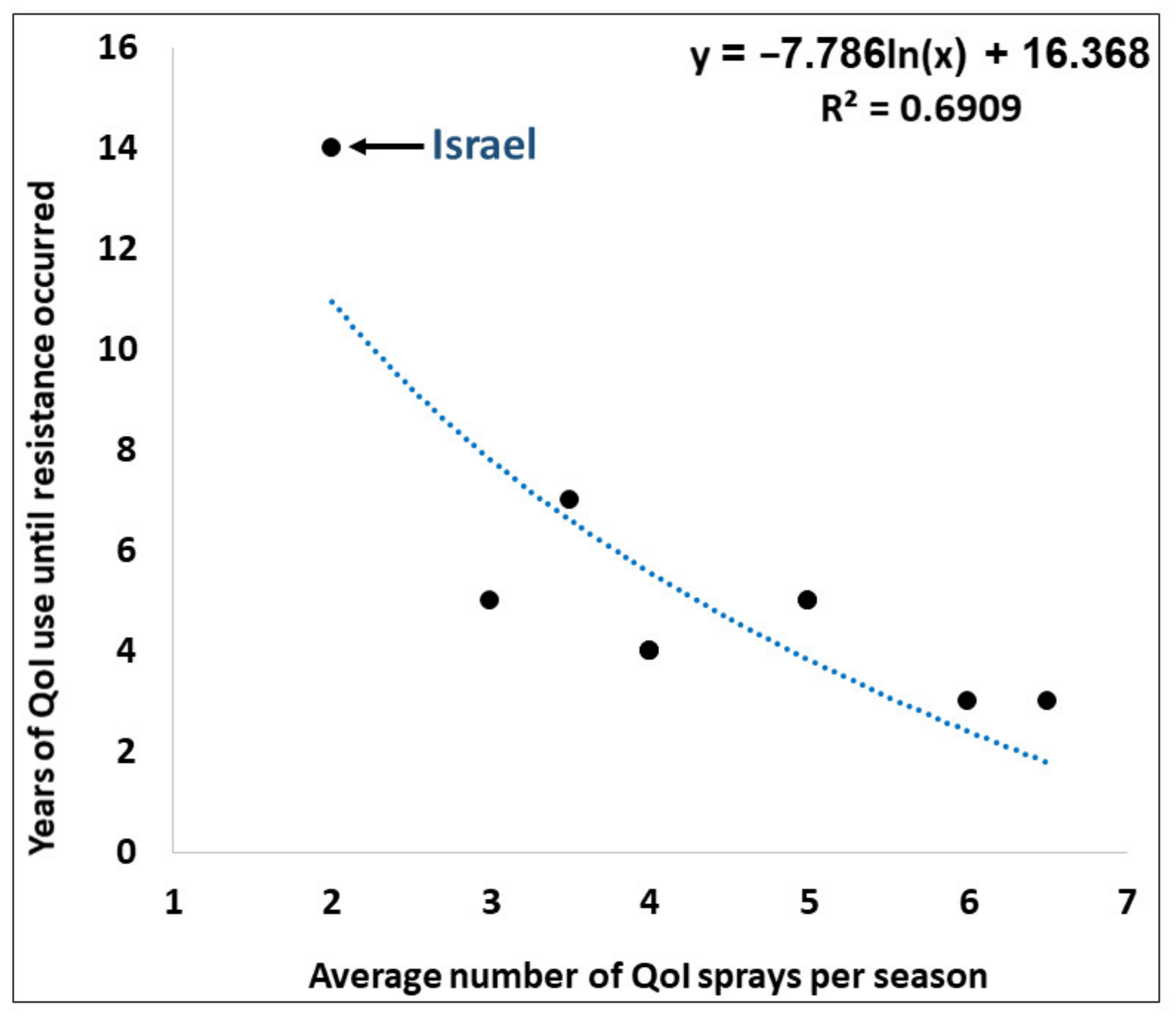
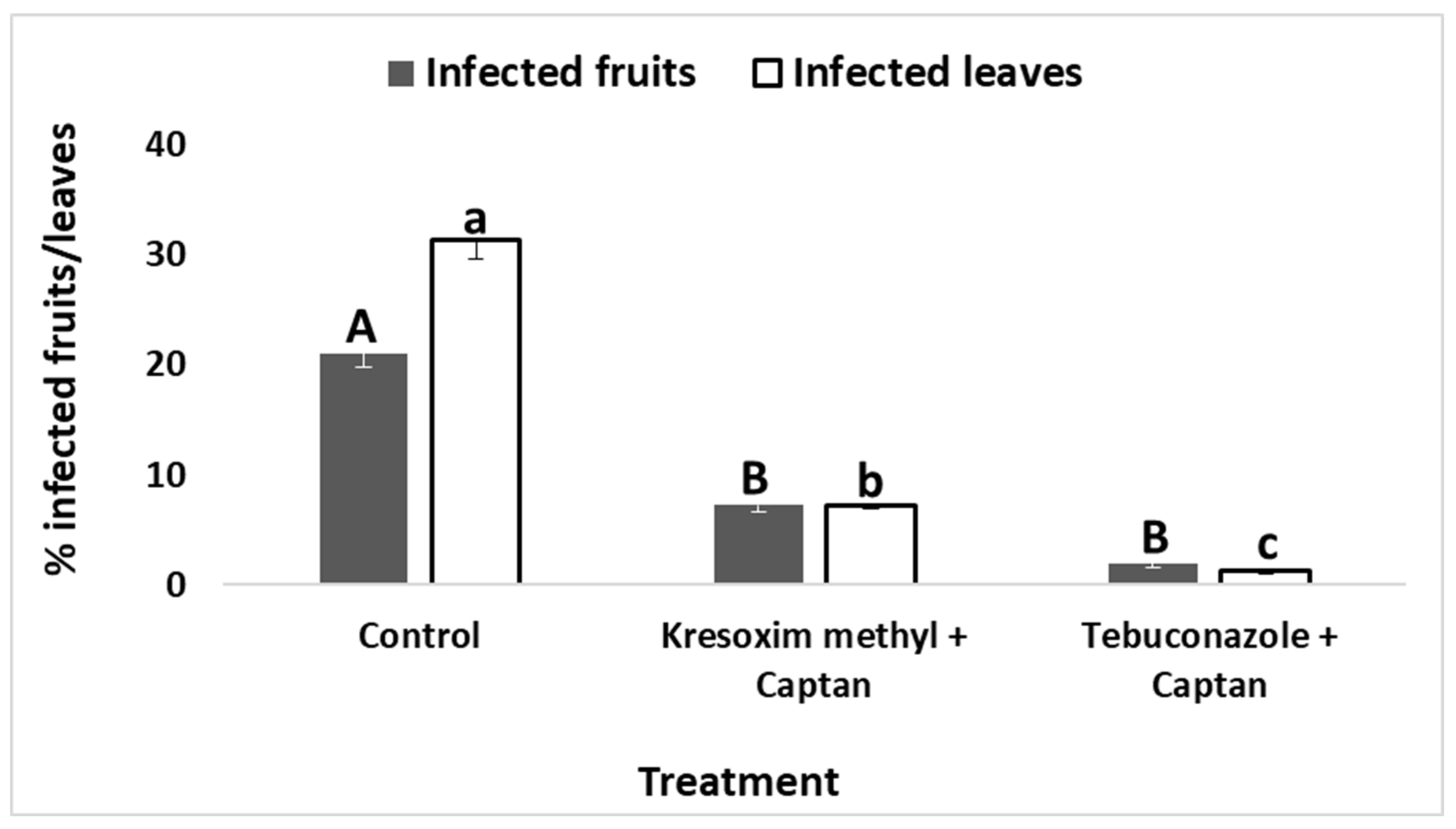
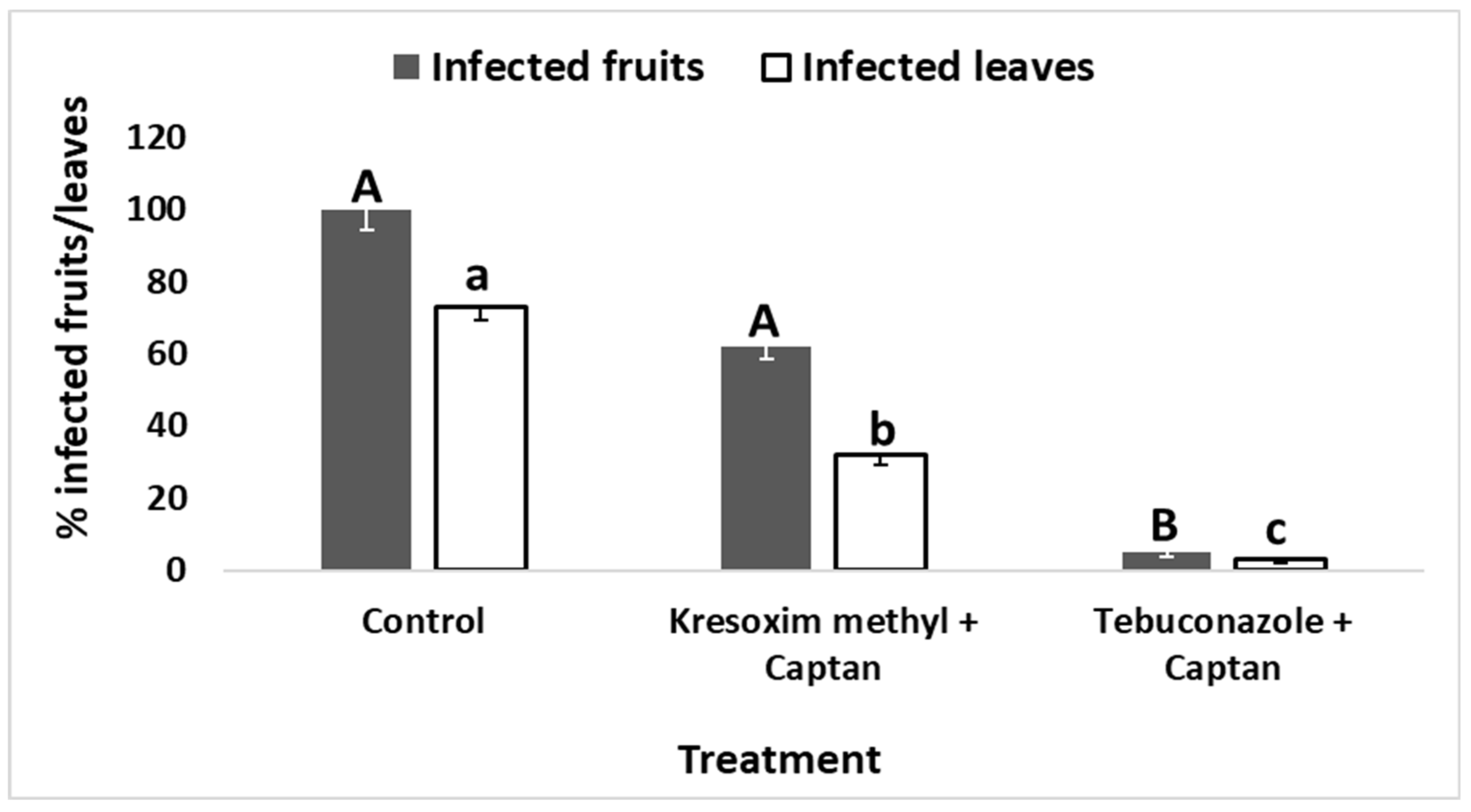
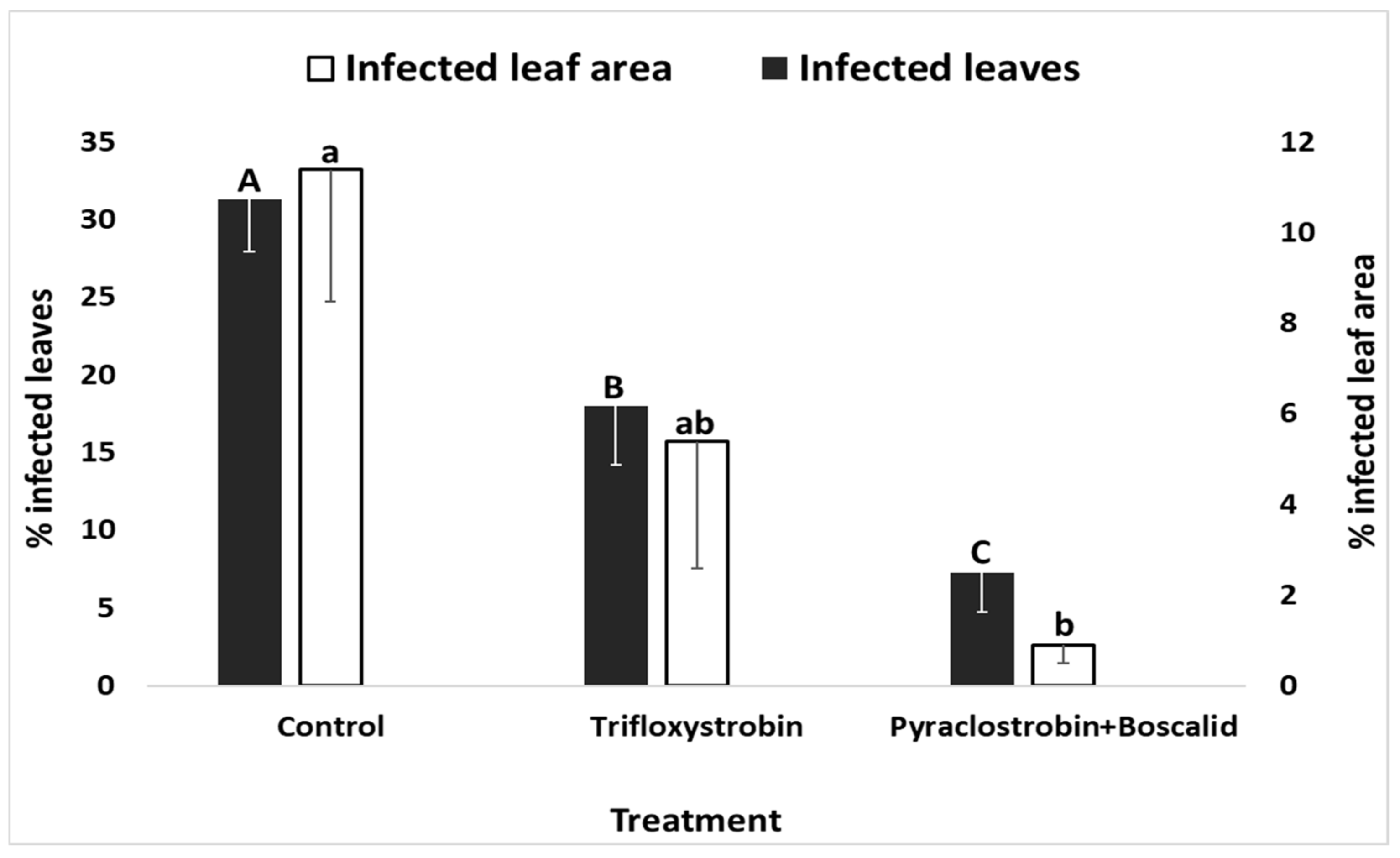
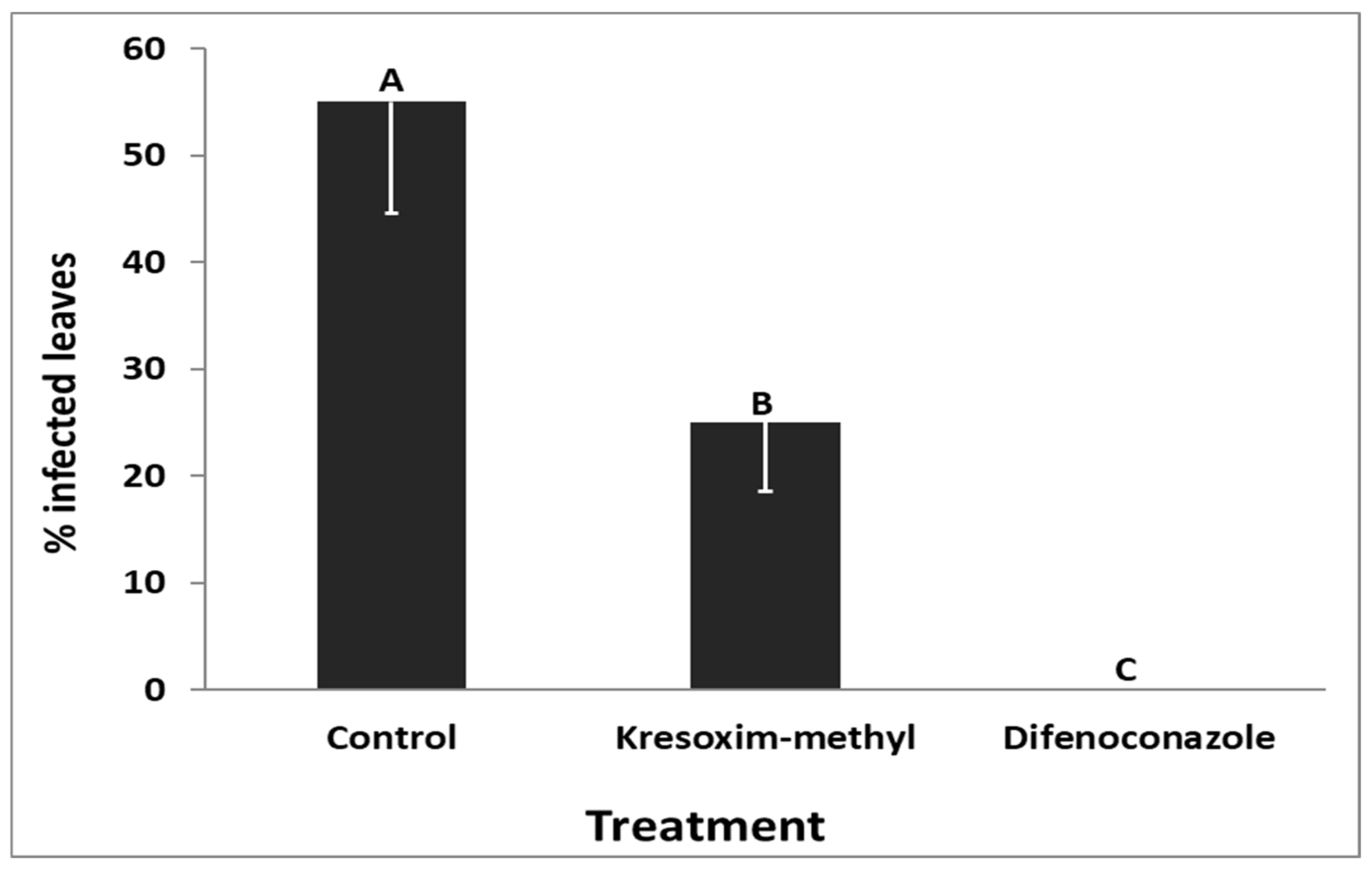
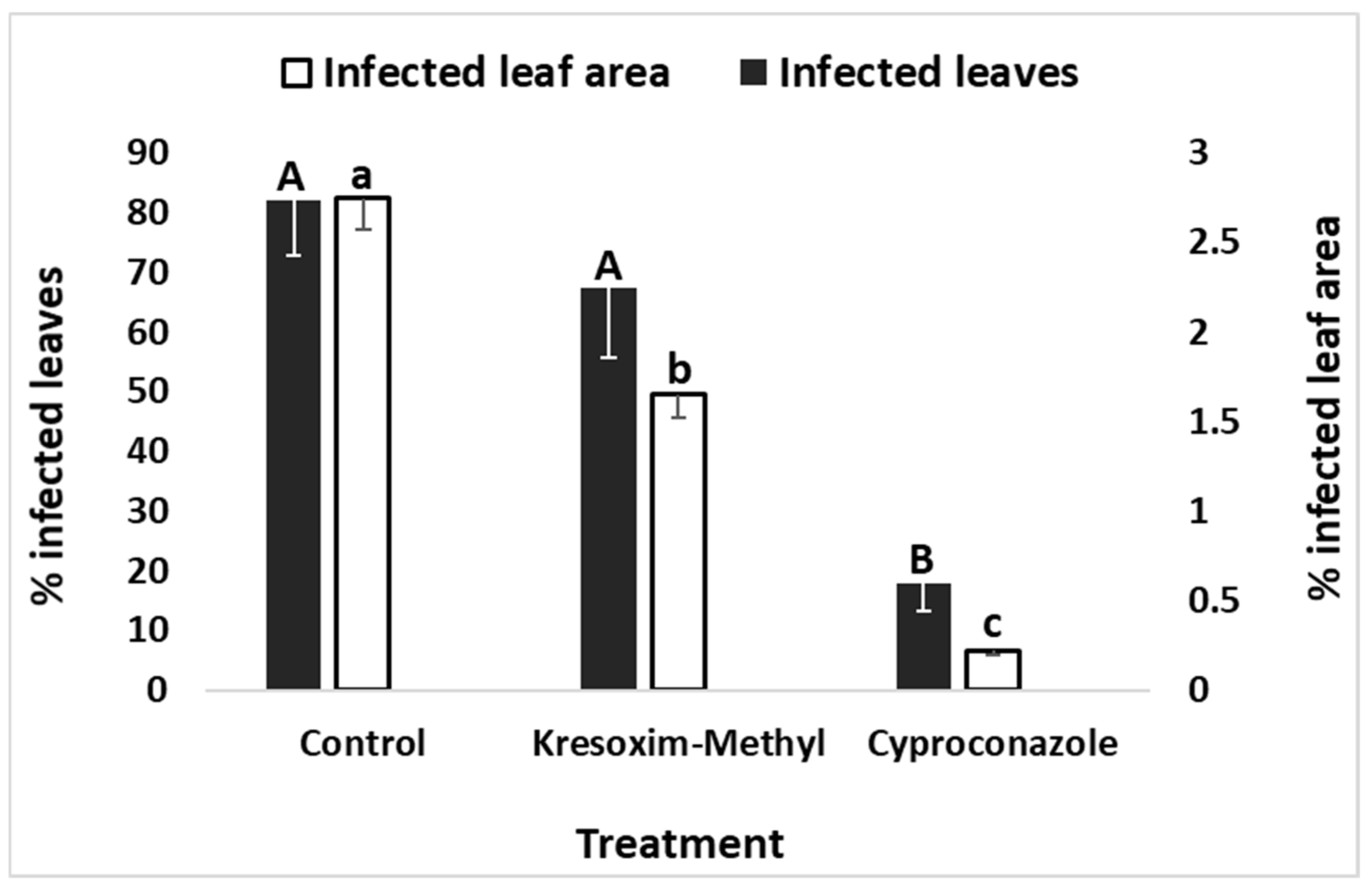
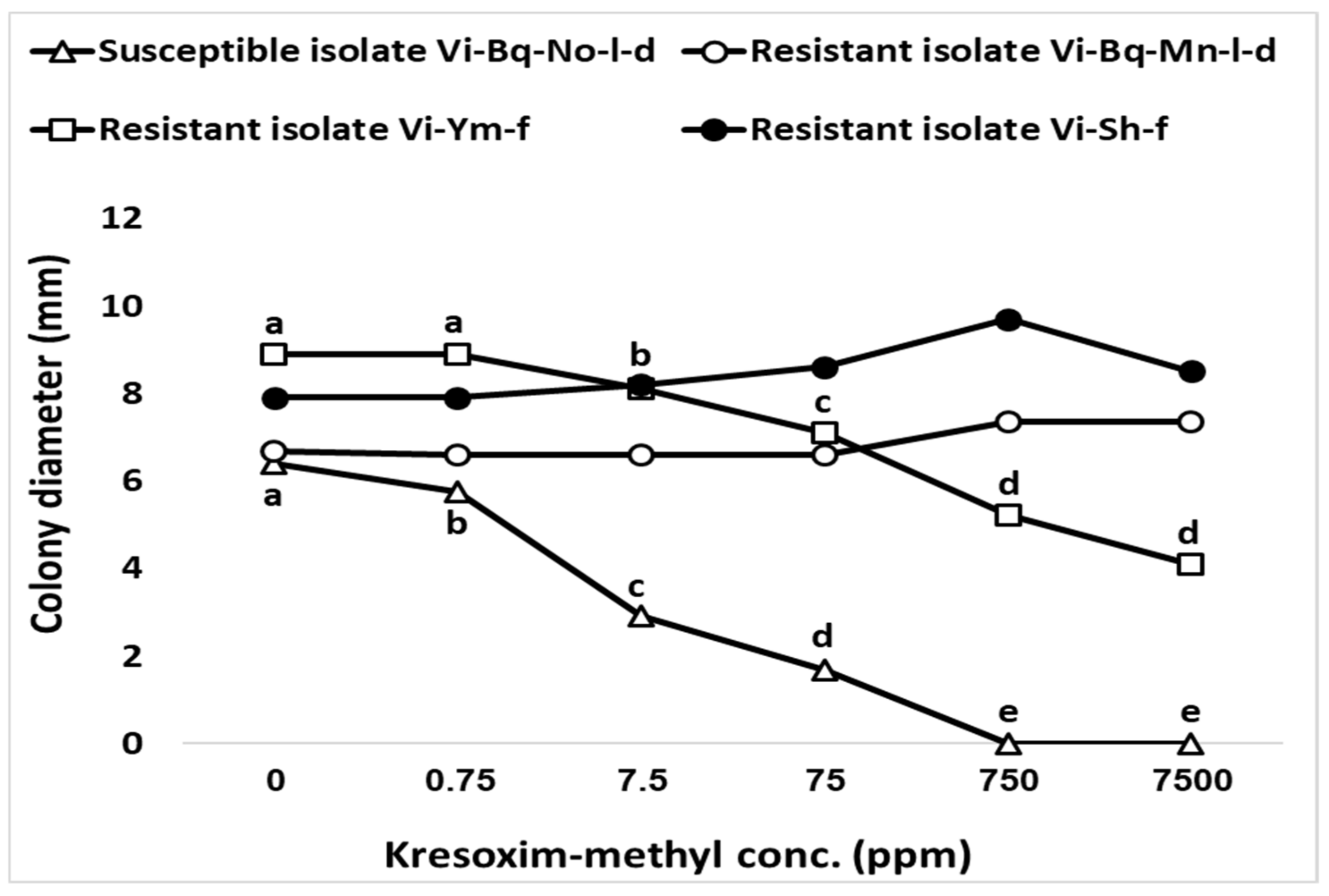
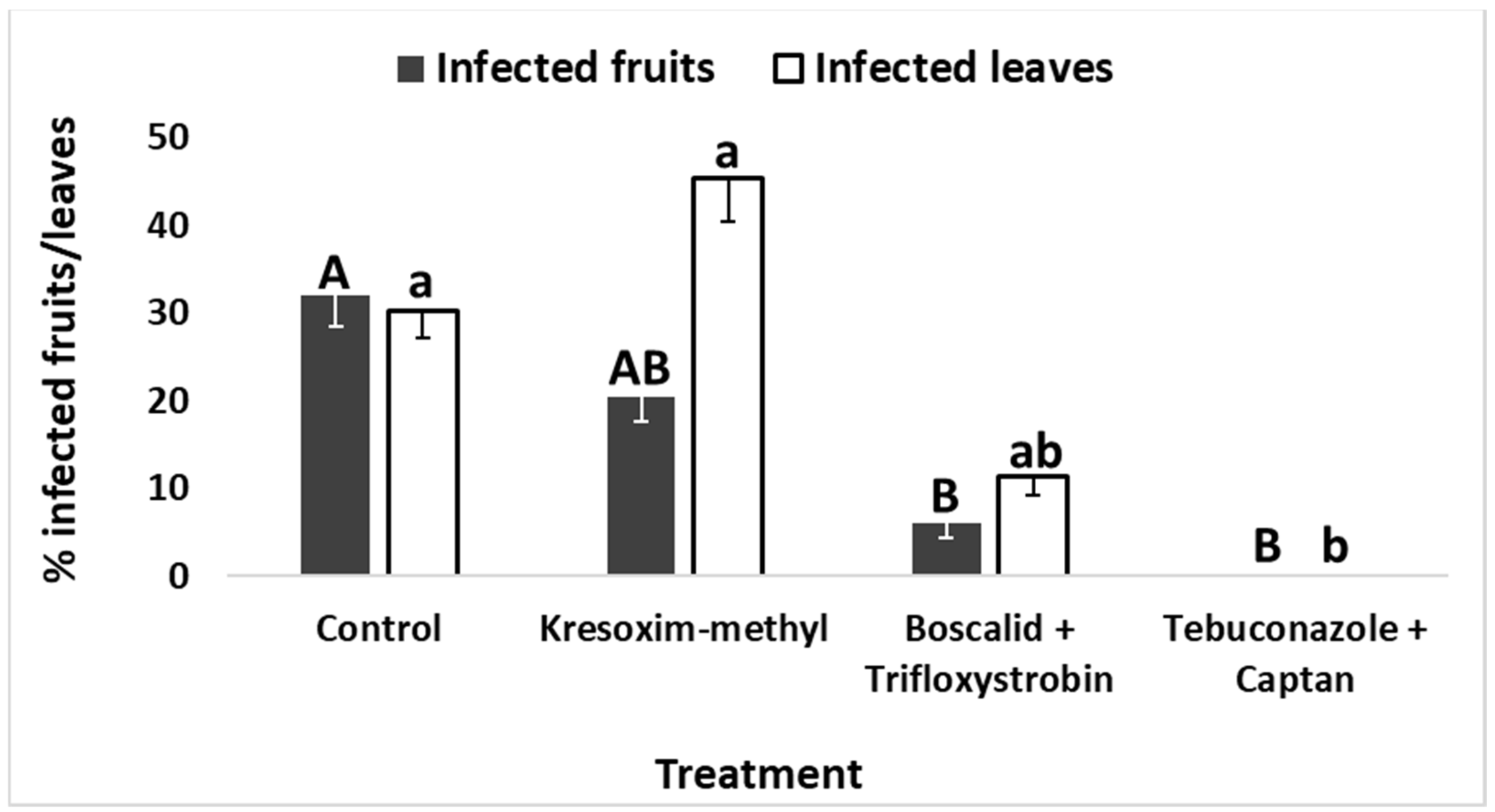
| Product Name | Active Ingredient | % Active Ingredient | Formulation 1 | Producer and Country | Fungicide Group 2 | FRAC Code |
|---|---|---|---|---|---|---|
| Stroby | Kresoxim-methyl | 50 | WG | BASF, Germany | QoI | 11 |
| Flint | Trifloxystrobin | 50 | WG | Bayer CropScience Ltd., Germany | QoI | 11 |
| Score | Difenoconazole | 25 | SC | Syngenta, Switzerland | DMI | 3 |
| Atemi-Extra | Cyproconazole | 10 | SC | Syngenta, Switzerland | DMI | 3 |
| Merpan | Captan | 50 | WP | Adama Makhteshim, Israel | multi-site | M04 |
| Orpan | Captan + tebuconazole | 32 + 8 | SC | Adama Makhteshim, Israel | multi-site + DMI | M04 + 3 |
| Discovery | Boscalid + trifloxystrobin | 17.7 + 10 | SC | Tapazole, Israel | SDHI + QoI | 7 + 11 |
| Benelus | Cyprodinil + tebuconazole | 18.75 + 12.5 | EC | Adama Makhteshim, Israel | AP + DMI | 9 + 3 |
| Bellis | Pyraclostrobin + boscalid | 12.8 + 25.2 | WG | BASF, Germany | QoI + SDHI | 11 + 7 |
| Luna Experience | Fluopyram + tebuconazole | 20 + 20 | SC | Bayer CropScience Ltd., Germany | SDHI + DMI | 7 + 3 |
| Trial | Year | Location, Region | Treatments 1 | Apple Cultivar | Age of Trees (Years) | Rootstock | # of Sprays | Beginning of Sprays | End of Sprays |
|---|---|---|---|---|---|---|---|---|---|
| 1 | 2010 | Majdal-Shams, Golan | Stroby (0.015%) + Merpan (0.25%), Orpan (0.3%), Merpan (0.25%), Control untreated | Starking | 13 | MM.106 | 6 | March 18 (BBCH-09 2) | June 6 |
| 2 | 2011 | Alonei-Ha’bashan, Golan | Stroby (0.015%) + Merpan (0.25%), Orpan (0.3%), Merpan (0.25%), Control untreated | Starking | 7 | Hashabi (local rootstock) | 7 | April 8 (BBCH-09) | June 1 |
| 3 | 2011 | Sha’al, Golan | Stroby (0.015%), Orpan (0.3%), Control untreated | Starking | 8 | MM.106 | 6 | April 13 (BBCH-11) | May 25 |
| 4 | 2011 | Kidmat-Tzvi, Golan | Stroby (0.015%), Control untreated | Starking | 3 | MM.106 | 6 | April 13 (BBCH-11) | May 25 |
| 5 | 2015 | Alonei-Ha’bashan, Golan | Flint (0.015%), Bellis (0.05%), Control untreated | Starking | 11 | MM.106 | 4 | March 29 (BBCH-09) | April 20 |
| 6 | 2016 | Yesud HaMa’ala, Gallile | Stroby (0.015%), Score (0.01%), Control untreated | Odem | 3 | MM.106 | 3 | March 13 (BBCH-09) | April 11 |
| 7 | 2017 | Kadesh valley, Upper Gallile | Stroby (0.015%), Atemi Extra (0.03%), Control untreated | Anna | 12 | Hashabi (local rootstock) | 5 | March 13 (BBCH-09) | April 13 |
| State | Year of QoI Resistance Appeared | Years of QoI Use until Resistance | Number of QoI Sprays per Season | Average Rainfall (mm) in Season 1 | Reference |
|---|---|---|---|---|---|
| Southern Chile | 2003 | 5 | 3 | 433.00 | Sallato et al. [24] |
| USA (Michigan) | 2001 | 4 | 4 | 334.60 | Köller et al. [15] |
| USA (New York) | 2004 | 4 | 4 | 449.50 | Turechek & Köller, [25]; Köller et al. [26] |
| France (Rhône-Alpes) | 2002 | 4 | 4 | 305.00 | Fontaine et al. [13] |
| Swiss | 1997 | 3 | 4–8 | 381.00 | Küng Färber et al. [14] |
| Serbia | 2002 | 5 | 3–7 | 554.00 | Stević et al. [18] |
| Northern Germany | 2000 | 3 | 4–9 | 255.70 | Köller et al. [15] |
| Northern Italy | 2002 | 5 | 3–7 | 278.70 | Fiaccadori et al. [27] |
| Turkey (Isparta) | 2005 | 7 | 3–4 | 149.20 | Turan, [19]; Turan et al. [20] |
| Northern Israel | 2011 | 14 | 2 | 49.10 | Reuveni et al. [4] and current study |
| Sha’al (2011) Trial-3 | Kidmat Tzvi (2011) Trial-4 | |
|---|---|---|
| Treatment (Rate in %) | % Infected Fruits | |
| Untreated control | 92.0 a 2 | 91.5 a |
| Kresoxim-methyl (0.015) | 43.5 b | 40.0 b |
| Tebuconazole + Captan (0.3) 1 | 8.5 c | n.t 3 |
| % Efficacy Relative to Control 1 | ||||
|---|---|---|---|---|
| Isolate 2 | Kresoxim-Methyl | Difenoconazole | Degree of Sensitivity to Kresoxim-Methyl 3 | Degree of Sensitivity to Difenoconazole |
| V.i-Mat-l-d | 0 | 100 | R | S |
| V.i-Mat-l-u | 0 | 100 | R | S |
| V.i-Bq-Gs-l-d | 3 | 100 | R | S |
| V.i-Ym-f | 8.2 | 84 | R | S |
| V.i-Hv-l-u | 17.3 | 100 | R | S |
| V.i-ER-f | 26 | 100 | R | S |
| V.i-Al-l-d | 28.7 | 100 | R | S |
| V.i-Bq-Gs-f | 33.3 | 100 | M | S |
| V.i-Ym-l-d | 55.3 | 100 | M | S |
| V.i-Bq-No-l-d | 77 | 78 | S | S |
| Treatment (Maximal Concentration) 1 | Colony Diameter (mm) at Maximal Concentration | EC50 2 | R2 |
|---|---|---|---|
| Control | 23.08 a 3 | - | - |
| Kresoxim-methyl (75) | 20.42 b | >75 | 0.926 |
| Trifloxystrobin (75) | 13.08 c | >75 | 0.886 |
| Difenoconazole (50) | 4.08 d | 0.124 | 0.866 |
| Captan (1200) | 1.00 e | 64.8 | 0.829 |
| Captan + tebuconazole 4 (1200) | 1.00 e | 44.3 | 0.879 |
| Boscalid + pyraclostrobin 5 (190) | 1.00 e | 1.66 | 0.878 |
| Cyprodinil + tebuconazole 6 (312.5) | 1.00 e | 0.14 | 0.930 |
| Isolate (N) 1 | Sequence 2 |
|---|---|
| V.i-Bq-No-l-d (1) | ATGAGCCTATGGGCTGCAACTGTCATC 4 |
| V.i-ER-f (27) | ATGAGCCTATGGGGTGCAACTGTCATC |
| AF004559 3 | ATGAGCCTATGGGGTGCAACTGTCATC |
| Treatment (Concentration in %) 1 | % Infected Leaves | % Infected Fruits |
|---|---|---|
| Control | 69.5 a | 28.5 a |
| Thiophanate-methyl (0.05) | 44 b | 10 b |
| Thiophanate-methyl (0.05) + captan (0.25) | 4 c | 2.5 bc |
| (fluopyram + tebuconazole)2 (0.035) | 7 c | 6 bc |
| (fluopyram + tebuconazole) (0.035) + captan 3 (0.25) | 1.5 c | 0.01 c |
| Difenoconazole (0.02) | 4 c | 3 bc |
| Difenoconazole (0.02) + captan (0.25) | 7 c | 1 c |
| (cyprodinil + tebuconazole) 4 (0.1) | 2.2 c | 7 bc |
| (captan + tebuconazole) 5 (0.3) | 5.5 c | 2.67 bc |
Publisher’s Note: MDPI stays neutral with regard to jurisdictional claims in published maps and institutional affiliations. |
© 2021 by the authors. Licensee MDPI, Basel, Switzerland. This article is an open access article distributed under the terms and conditions of the Creative Commons Attribution (CC BY) license (http://creativecommons.org/licenses/by/4.0/).
Share and Cite
Gur, L.; Levy, K.; Farber, A.; Frenkel, O.; Reuveni, M. Delayed Development of Resistance to QoI Fungicide in Venturia inaequalis in Israeli Apple Orchards and Improved Apple Scab Management Using Fungicide Mixtures. Agronomy 2021, 11, 396. https://doi.org/10.3390/agronomy11020396
Gur L, Levy K, Farber A, Frenkel O, Reuveni M. Delayed Development of Resistance to QoI Fungicide in Venturia inaequalis in Israeli Apple Orchards and Improved Apple Scab Management Using Fungicide Mixtures. Agronomy. 2021; 11(2):396. https://doi.org/10.3390/agronomy11020396
Chicago/Turabian StyleGur, Lior, Keren Levy, Amotz Farber, Omer Frenkel, and Moshe Reuveni. 2021. "Delayed Development of Resistance to QoI Fungicide in Venturia inaequalis in Israeli Apple Orchards and Improved Apple Scab Management Using Fungicide Mixtures" Agronomy 11, no. 2: 396. https://doi.org/10.3390/agronomy11020396
APA StyleGur, L., Levy, K., Farber, A., Frenkel, O., & Reuveni, M. (2021). Delayed Development of Resistance to QoI Fungicide in Venturia inaequalis in Israeli Apple Orchards and Improved Apple Scab Management Using Fungicide Mixtures. Agronomy, 11(2), 396. https://doi.org/10.3390/agronomy11020396








